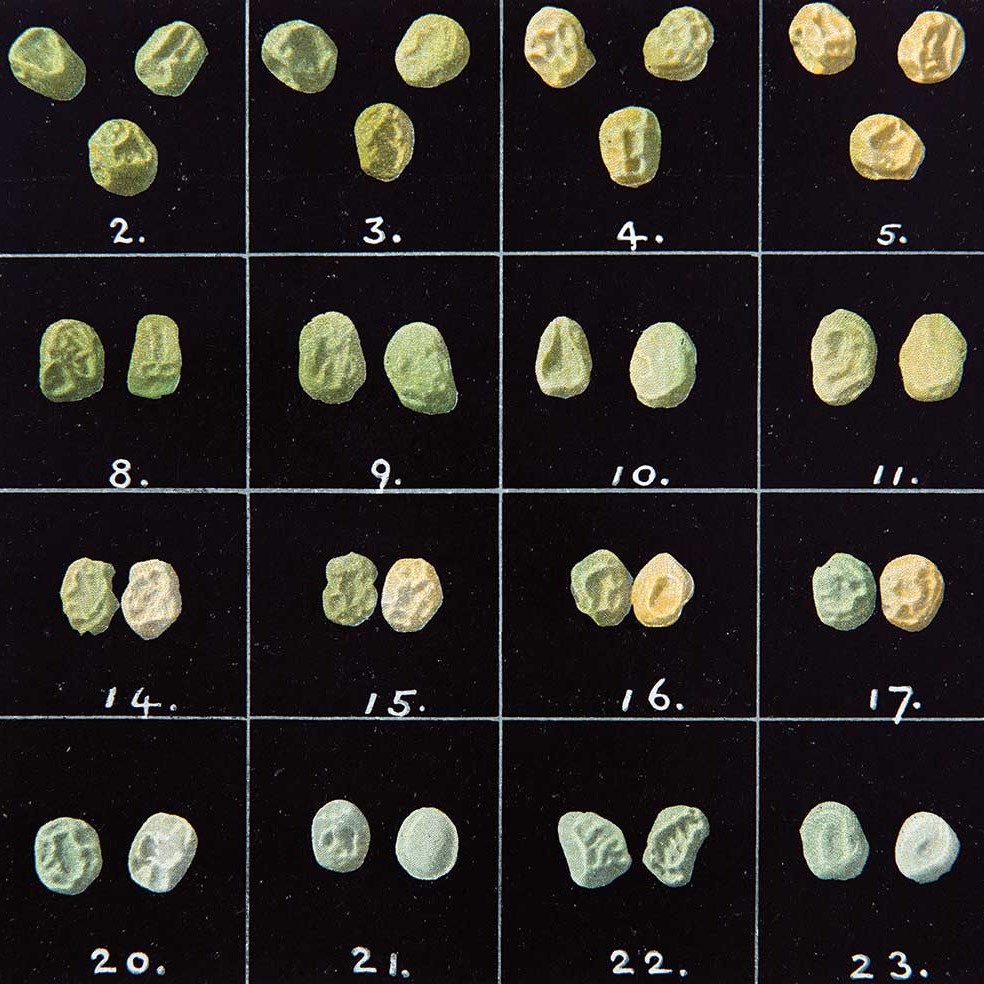Fifty shades of peas
Image of peas from Weldon, W. F. R. 1902. Mendel’s laws of alternative inheritance in peas. Biometrika, 1:228-254.
For many people, the forefather of genetics is Gregor Mendel, an Augustinian friar at St Thomas’ Abbey in Moravia, now Brno in the Czech Republic.
Scientifically-minded since childhood, Mendel was fascinated by the way in which traits could be inherited down the generations, originally asking his bosses at the Abbey if he could carry out breeding experiments with mice to find out how it all worked.
Feeling that this was a bit of an inappropriate occupation for a man of the cloth, Mendel’s superiors steered him towards the Abbey gardens, in which he began to grow thousands of pea plants over eight years, pollinating individual plants with a paintbrush to see how various characteristics – including height, petal colour, and the hue and wrinkliness of the seeds – was inherited, carefully counting more than 40,000 flowers and 300,000 peas.
Gregor Mendel
Using nothing more than statistics and a lot of hard thought, he figured out the basics of genetics – a set of rules now known as the laws of Mendelian inheritance – at a time before anything was known about genes or DNA.
First, he realised that there must be two copies of each component that imparts a particular characteristic – one from mummy plant, and the other from dad – and only one version of each trait-maker ends up coming from each. We now know that these trait-makers are genes, and we do indeed inherit one set from each parent.
Second, he discovered recessive and dominant characteristics, for example, just one purple petal gene being enough to give a flower purple petals.
Third comes the law of independent assortment: genes are independently and randomly sorted into the eggs and sperm (or pollen and pistils) of the parents, and don’t get blended together.
Presented at a meeting of his local scientific society in February 1865 and published in a little-known German journal, Mendel’s ‘Experiments on Plant Hybridisation’ contained the seeds of the future field of genetics.
Yet despite their groundbreaking insights into the secrets of nature, Mendel’s results languished in obscurity for decades, until being rediscovered and translated into English by British biologist William Bateson – the founder of the Genetics Society – in 1901. While Bateson gets the glory for the popularisation of Mendel’s ideas in the early 20th century, others also deserve a nod, notably Dutchman Hugo de Vries, German Carl Correns and the Austrian Erich Tschermak.
But while most of the budding plant genetics community picked up Mendel’s ideas and ran with them, there were a few dissenting voices. One was Raphael Weldon, who took a closer look at Mendel’s maths and wasn’t entirely convinced, noting in a letter to a colleague that “I can’t help wondering if the results are too good?”
Even more fundamentally, Weldon realised that Mendel’s insistence that characteristics segregated neatly into a few discrete categories simply wasn’t true. And when you look at the patterns of inherited characteristics across the wider world, it’s clear that people are not peas. And even peas are not peas (or at least, not in the way that Mendel saw them).
To make his point, in 1902 Weldon published a paper entitled “Mendel’s Laws of Alternative Inheritance in Peas”, which is the closest thing to a hip-hop diss track in early 20th century genetics as you’re going to get.
Weldon brought the smackdown with a photograph of a neatly arranged crop of peas, which should all be green or yellow according to Mendel’s rules. Instead, Weldon showed a spectrum of colours from grassy green through to bright yellow – fifty shades of peas, indeed.
Weldon, and others after him, showed that genetic inheritance is all about variation and complexity – our traits, characteristics and health are created through manifold interactions between thousands of genes, millions of subtle genetic variations, the influence of the world around us, and the random hand of chance.
Mendel’s rigid laws only apply to a relatively small number of traits and diseases, and even now there seems to be a lot of blurriness around the edges. Now that researchers can scan through the DNA of many thousands of healthy people, they are starting to discover genetic superheroes – people carrying gene faults that should make them sick, but they are perfectly healthy – a fascinating subject I covered in a talk at New Scientist Live in 2018 if you’d like to learn more.
As for Mendel himself, after his work on pea plants failed to hit the heights, he turned his scientific attention to breeding killer bees (allegedly), before taking over as Abbot and embarking on a fight with the local government about taxes.
Today, his garden at St Thomas’ Abbey has been turned into a museum celebrating his life and work, and is well worth a nerdy day trip, should you want to dig deeper into the story of Mendel and his peas.
Further reading:





